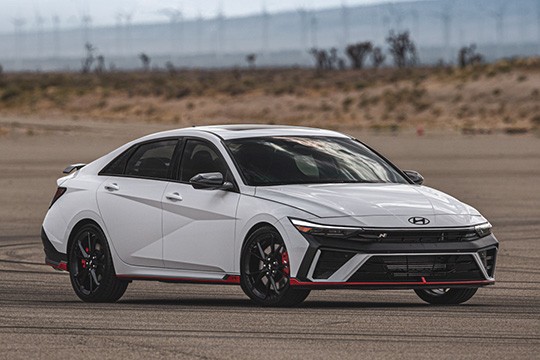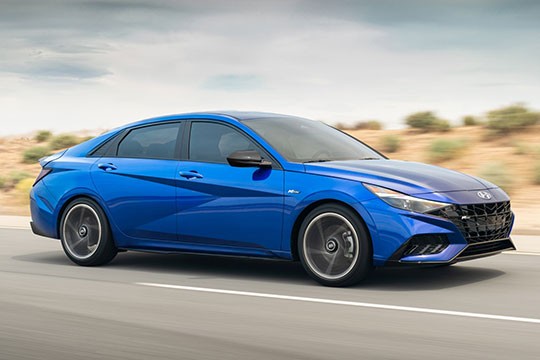HYUNDAI Elantra N Models/Series Timeline, Specifications & Photos
First production year: 2020
Engines: Gasoline,
Hyundai refreshed the seventh generation of the Elantra, and along with it, it brought some updates to the Elantra N version, which was the most powerful and the sportiest from its family.
Gone were the days when the Elantra was a mundane grocery-getter vehicle. By 2023, it became not just the best-selling Hyundai model of all time but also a threat to other automakers in the same segment. But the Korean automaker dared even more when it made the N version for the i30 and the Elantra. This time, the Elantra was a true contender against other sport compact vehicles on the market. Moreover, the refreshed version, or PE (Product Enhanced), as Hyundai liked to name it, came with several improvements in the safety department.
First, the exterior was modified so the car could show its potential. Hyundai installed new headlights on the entire lineup, featuring slimmer LED daytime running lights on their upper side. On the Elantra N, these were visually connected via a black stripe and a body-colored slat above the main black grille. Underneath it, the automaker installed exclusively for the Elantra N a mate black trim on the bumper, which was continued on the lower side by an A-shaped cooling area flanked by a pair of side scoops needed to vent the front brakes. The aggressive look on the car's front fascia was emphasized by the lower bumper, which sported a red lip spoiler at the bottom. One particular element of this version of the Elantra was the carmaker's logo placed on the hood. While the rest of the range featured silver ones, this one was black. From its profile, the Elantra N boasted its forged, black, 19" alloy wheels. At the back, the automaker made an H-design with the vertical lights of the taillights and a horizontal red strip that crossed the rear fascia. The car's sporty image was completed by the small spoiler on the trunk lid and two side-mounted exhausts underneath the bumper, flanking the diffuser.
Inside, the Elantra N boasted high-bolstered bucket seats with integrated headrests and cut-aways for four-point harnesses. Still, since the vehicle was designed for street use, those were mostly just for decoration. In front of the driver, the automaker installed a digital instrument cluster that showed two large dials for the tachometer and speedometer flanking the area reserved for the computer to display various information about the car's status. Atop the center stack, a 10.25" touchscreen for the infotainment unit featured wireless Android Auto and Apple CarPlay connectivity. Between the front occupants, the center console housed the selector for the automatic transmission and the button for the parking brake, which for the 2024 model-year was electric instead of a mechanic. In the back, the 60/40 split-folding bench seat could accommodate three adult-sized passengers. The Elantra N PE featured advanced safety features such as adaptive cruise control and side airbags for the rear seats.
Under the hood, the Korean automaker installed its already famous two-liter turbocharged powerplant that sent 276 HP to the front wheels via a seven-speed dual-clutch automatic gearbox. Moreover, for short periods, the car could deliver up to 286 HP.
The Elantra N-Line was launched in April 2020 just when the pandemic hit the world. But the Koreans pushed forward with that jaw-dropping compact sedan that looked way more aggressive.
After Hyundai entered the World Rally Championship and started to be important on stages, the motorsport department was called and asked to give a helpful hand in developing of a sportier version for the i30 and soon after, for the Elantra Sedan N-Line.
The exterior look of the 2020 Elantra was different than its predecessor. Its angular face, with a deep black grille at the front and swept-back headlights, might not have been very original, but they were different than the rest of the Hyundai line-up. The A-pillars were very raked and the streamlined greenhouse resembled a four-door coupe vehicle. The back of the car was more of a fastback than a classic, three-box, sedan.
Inside, the Elantra N-line was offered with a choice for the instrument cluster with either analog dials or a completely digital panel. On the center stack, there was another display for the infotainment system, which allowed connectivity with a smartphone either via Apple CarPlay or Android Auto. An interesting feature was the “Drive Mode” knob placed at the same level as the steering on the outer side of the dashboard. It was easy to reach only for the driver. The two front seats were separated by two bars over the center console.
Under the hood, the Hyundai Elantra N Line featured a rather disappointing engine when compared to the car's look. It offered 210 hp from a 1.6-liter turbocharged unit with direct-injection. It was paired to a 6-speed manual transmission. On specific markets, it was available with a 7-speed dual-clutch automatic gearbox.

